Arts
Not Your Mama’s Mother’s Day Benefit
 The vivacious Jillian Bessett – leader and singer/songwriter, keyboardist and multi-instrumentalist of Tucson’s beloved Jillian & The Giants – is spearheading a concert fundraiser for Emerge! Center Against Domestic Abuse on May 13. You should go.
The vivacious Jillian Bessett – leader and singer/songwriter, keyboardist and multi-instrumentalist of Tucson’s beloved Jillian & The Giants – is spearheading a concert fundraiser for Emerge! Center Against Domestic Abuse on May 13. You should go.
Here are 10 reasons why.
The incredible event line-up:
- The Surfbroads: “Hot Broads Playing Cool Surf”
- Jillian & The Giants: “Indie Rock with Soul”
- Street Blues Family: “Neo-soul, Jazz, Rock, Blues, Hip-Hop, Gospel”
- Tales From The Trash: “One Delightfully Trashy Mother’s Day Themed Art Pop Up”
- Emcee Extraordinaire: Stephen Boughton
Five reasons for social justice:
- One in four women and one in seven men have been victims of severe physical violence by an intimate partner in their lifetime.1
- A portion of the proceeds benefit Emerge! Center Against Domestic Abuse.
- Emerge! Center Against Domestic Abuse provides domestic abuse crisis intervention and housing, prevention, education, support, and advocacy services to anyone experiencing domestic abuse.2
- In Arizona, first- and second-time domestic violence offenders are not charged with domestic violence; only the third incident is charged as domestic violence. First and second offenders are charged with offenses that then have ‘domestic violence flags’ attached.3
- There were 109 domestic violence-related deaths in Arizona in 2014; in 2012, Arizona ranked eighth in the nation in femicides per capita.3
Zocalo conducted a quick Q&A with Jillian over email to find out more about the event.
What was the impetus to create this event fundraiser for Emerge?
The greater impetus for this benefit is seeing women and female-identifying people lose a lot of
support in our current political climate and wanting to contribute some good in some small way.
During times when public funding is cut that supports our most vulnerable, nonprofit organizations like Emerge need to be prepared to help fill in the gaps. I love the idea of celebrating Mother’s Day weekend by having an opportunity to be more nurturing, giving, and generous to our community.
How/why were these bands chosen?
The bands on this bill aren’t just incredible musicians but they’re also incredible people, which is why they were pulled together for this event. Velvet Hammer, the drummer and founder of The Surfbroads quietly volunteers every week for The Lot on 22nd.

The Surfbroads
Photo by Julius Schlosburg
Rey Murphy, the frontman for Street Blues, practices guerrilla style support for people on the street with blanket drives and cookouts at the park. Amy Mendoza is a licensed therapist. Gigi Owen is a social scientist and activist who we’re all not so secretly hoping runs for office. These aren’t just musicians but active, involved members of our community who go the extra mile in support of the big picture.
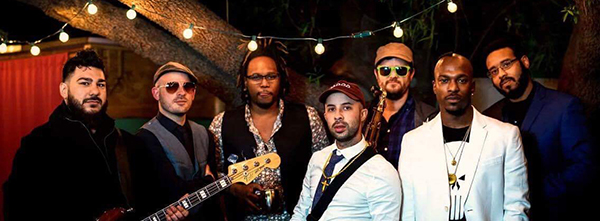
Street Blues Family
Photo by Julius Schlosburg
The other beautiful thing about this group of bands is how interconnected they are. A shortlist of all the other projects connected to these musicians: Loveland, Velvet Panthr, Sugar Stains, Katie Haverly and the Aviary, Amy Mendoza and the Strange Vacation, Copper and Congress, Three Kings, Shrimp Chaperone, Trees Speak, Leila Lopez Band, West Texas Intermediate, The Cloud Walls, Orkesta Mendoza, Keli and the Big Dream, etc.
Long story short, a lot of the Tucson music scene is represented with these players and we’re expecting a lot of surprise guests throughout the night.
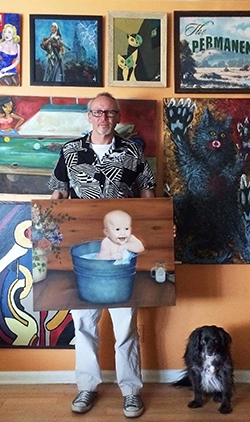
Mark Bloom and his dog Alfie with some of the permanent Tales from the Trash collection.
Photo by Velvet Hammer
How did Tales from the Trash get involved and what does “delightfully trashy” entail?
Tales from the Trash is an art show curated by Steve Purdy and my friend Mark Bloom. The premise is found discarded art that’s given a new lease on life in a cheeky art show format. The art is typically bad, odd, and peculiar in some form or another. But these unloved paintings and drawings get a frame and some space in the world to be looked at and appreciated – which is a pretty wonderful thing. If that’s not a metaphor I don’t know what is.
Not Your Mama’s Concert and Art Show Benefit for Emerge! is Saturday, May 13 at Flycatcher, 340 E. 6th St. The event kicks off at 8 p.m. and there is a $7 suggested donation. More information is at Facebook.com/jandthegiants.
References
- National Coalition Against Domestic Violence. (2015). Retrieved from www.ncadv.org/learn-more/statistics
- Emerge! Center Against Domestic Abuse. (2017). Retrieved from www.emergecenter.org
- National Coalition Against Domestic Violence. (2015). Domestic violence Arizona statistics. Retrieved from www.ncadv.org/files/Arizona.pdf
“Bycatch” – An Artistic Homage to the Throwaways
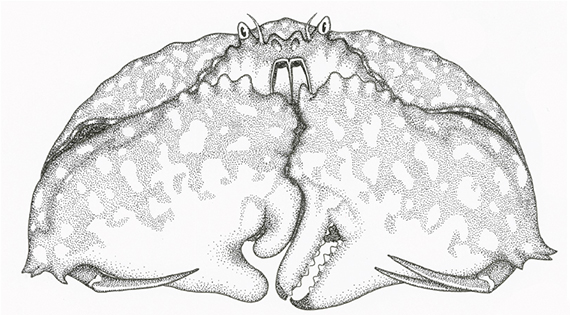
Shame-faced Crab illustration by Maria Johnson.
The sound of waves lapping on the side of a fishing boat sonically greets you when entering the Hanson Gallery at The University of Arizona Museum of Art. It emanates from a small computer speaker in the corner, subtly broadcasting the audio associated with the 14-foot-wide, 10-foot-tall video projection on the room’s east wall.
As you turn to watch the video projection, your eyes pause to take in the bar table in the middle of the room. Maybe you salivate a bit when you see the faux shrimp cocktail presentation adorning the table, complete with white wine glasses, red napkins and poetic menus. Maybe you imagine yourself sitting on one of those black bar stools and squeezing lemon on the tasty crustacean before dipping it into cocktail sauce and popping it into your mouth, slowly savoring the meaty delicacy. But your eyes are pulled to the east wall, to watch the projection of what takes place in order to bring this delightfully delicious arthropod to our collective plates and our – seemingly insatiable – palates.
The 11-minute video is a montage of excerpts filmed on a Gulf of California shrimp trawler, a vessel that drags several nets along the sea floor to capture brown shrimp during the night when the shrimp are bedded down in the aquatic bottom, scientifically known as the benthic zone. The projection brings powerful moving imagery to the gallery’s multimedia “Bycatch” exhibit that features gorgeously detailed ink on Bristol paper illustrations by Maria Johnson, a marine conservationist and Prescott College adjunct professor. Accompanying her work is poignant poetry by Eric Magrane, who is both a PhD candidate in UA’s School of Geography and Development and a research associate with UA’s Institute of the Environment.
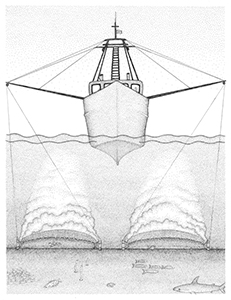
Trawler illustraion by Maria Johnson.
Johnson’s visual art and Magrane’s poetry pay homage to the sea creatures considered basura (trash) by the fisheries. Organisms such as crabs, turtles, eels, sting rays, sea horses and numerous fish species are the incidental casualties – comprising over 80% of what is caught in the nets – shoveled overboard to waiting sea lions and pelicans once the shrimp are sorted out from the writhing mass of beings dropped from the nets onto the boat decks.
The complement of illustrations, poetry and video draw you into a world of sea life, and sea death. It showcases the hidden actors, the bycatch, in this larger international economic drama. A drama that Johnson and Magrane were invited to document and catalogue as scientific observers on a Mexican fishing vessel through Prescott College’s Kino Bay Center for Cultural and Ecological Studies program.
In conversation with Johnson and Magrane, the two talk about the countless intricacies associated with the Gulf of California’s shrimp trawling industry. “As a geographer, I think about the multiple ways of trying to make some sense of what’s happening on the boat, because there is that process of being knee-deep in the fish, but then there’s global economic processes that are embodied in this interaction that is happening,” Magrane conveys. “It’s a way for humans to make a living. Although, most, if not all, of the people that work on the boats do not own the boats. There’s an effect that this has on the local and smaller scale fisher people of the region and the indigenous communities of the region, so it gets very complicated very quickly.”
As American consumers removed from the region’s fiscal realities, it may be easy enough to decide to stop consuming shrimp, to not be a part of this extractive industry and wonder how people can choose to earn their living by participating in disruptive ecological devastation. But the fact is, people are going to – understandably – do what they need to do to feed their families.
“The communities around the Gulf of California are so heavily focused on fishing, whether it’s large scale like trawling or tuna fishing or whether it is small scale,” Johnson explains. “It’s hard to find other (employment) options and fishing is a tradition. Many of the people working on the boats… it’s what their fathers did and it’s the life they have gone into for whatever reason.”
The other reality is the “very significant cultural differences, where different groups of people interact with different animals in different ways. You have some cultures where fish are food and that’s the only food that’s there. And some groups of people keep fish in aquariums. Or, we relate to cows in different ways, we relate to all these different species in different ways on this cultural and individual level,” Johnson elucidates.
Johnson and Magrane speak with compassion when discussing the industry’s players. They have reverence for the people who cast the nets, they feel for the creatures needlessly dying. I wonder how it is to be on the deck, cataloguing the organisms as they suffocate to death.
“You have to leave a part of your compassion in this other place and come back to it later, or at least that’s how I sometimes interact with it because if I’m just purely myself as a feeling and sensitive person on that boat, I just want to throw everything off board and save every little creature and cry, because it is so intense,” Johnson shares. “But you’re there and you have a job to do and you’re with people who do this for a living, and you want to respect that and collect data and have conversations, so I feel myself kind of leaving a part of that onshore and coming back to it.”
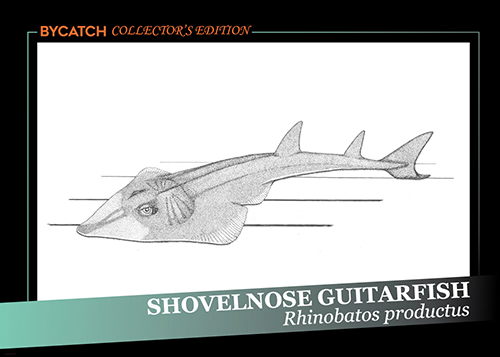
Shovelnose Guitarfish illustration by Maria Johnson.
Courtesy of Maria Johnson
“I think of the role of art and poetry and social science and social theory, in some sense, as being a way to pay witness to what is happening,” Magrane adds. “What going at this project through poetry and art does for me is to try to make some sort of sense, some sort of marking of this relationship that is being played out on the boat.”
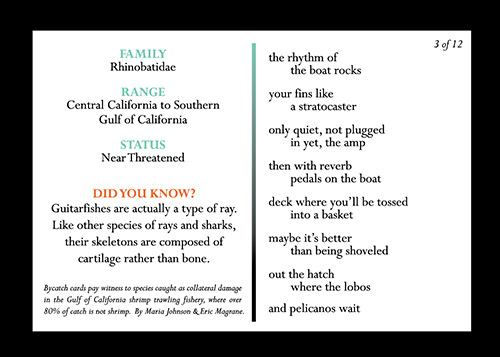
Poem by Eric Magrane.
Courtesy of Maria Johnson
“I know that a lot of what Eric and I have tried to do with this project, as Eric was saying about paying witness to these, not only the species (collectively) but these individuals both through poetry and through illustration, it’s been a really beautiful process. Going back to what I was saying earlier about leaving that compassion at home, this project has been a way for me to come back to that and really physically sit down and spend time with an actual individual (creature) that maybe we encountered in 2015, or that I encountered in 2013, that I actually remember, or that we actually weighed and measured and maybe we have a photo of it or maybe it’s something in our minds, or we remember that feeling of that fish’s slime on our hands or the way that it moved,” Johnson says, regarding their artistic processes. “Then to translate that into illustration and into poetry and honor and respect those individuals and those species, that’s been this very meaningful part of this project to me, that’s given me an opportunity to slow down and look at them as individuals and kind of make room to give that life space again, just in a different way.”
A unique aspect of the exhibit is the 3.5 by 2.5-inch trading cards on display, which are available for $10 in the museum’s store. They include Johnson’s drawings and excerpts of Magrane’s poetry of rolling couplets. (The poetic form, explains Magrane, was inspired by “the experience of being on the boat, the lull, the boat rolling on the water, the movement in that space.”) The idea behind the trading cards was based on Catholic remembrance cards, baseball cards and lotería cards.
“It’s both riffing off of baseball cards or trading cards and the back (of these cards) riffs off it too with the facts about the species along with excerpts from the poems. But the idea of using this form, a collector’s edition for something that is basura, plays against that,” Magrane shares. “Because bycatch, almost by definition, is not valued, it’s the leftover, it’s the waste. So, using the form of the collector’s edition trading cards kind of critiques that in a sense, puts a different play on that, there’s a little bit of cognitive dissonance with that there.”
“Bycatch” grew out of Johnson and Magrane’s involvement with the 6&6 Artists|Scientists project, which is an offshoot of the Next Generation Sonoran Desert Researchers (N-Gen) interdisciplinary network “of individuals and institutions committed to the rich social and ecological landscape that spans the mainland Sonoran Desert, the Baja California Peninsula, the Gulf of California, and the US-Mexico borderlands,” according to the NextGenSD.com website. Find details on the “Bycatch” project at NextGensd6and6.com.
The exhibit is on display through April 2 at the UA Museum of Art, 1031 N. Olive Rd. Call 520-621-7567 or visit ArtMuseum.arizona.edu for hours and admission prices. Pick up the March/April issue of Edible Baja Arizona to see several “Bycatch” illustrations and poems.
Borderlands Theater Relocates, Launches a $20K Fund Drive
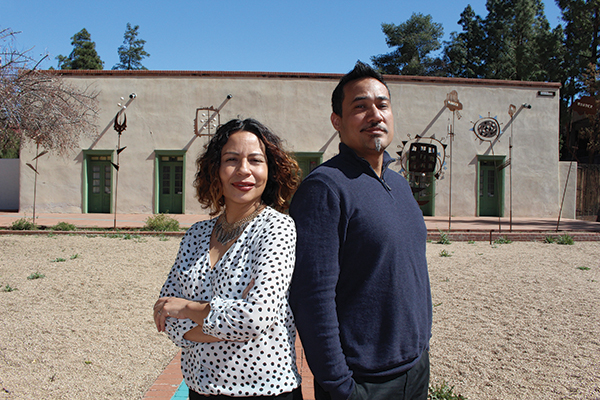
Borderlands Theater Marketing and Outreach Director Milta Ortiz (left) with Producing Director Marc Pinate (right) in front of the theater’s new office/community space, the Sosa-Carrillo-Fremont House museum, at 151 S. Granada Ave.
Photo by Gaby Hurtado
For over three decades, Borderlands Theater has survived on a shoestring budget with vitality and resilience. This pertinent production company, comprised of a four-person staff, is committed to creative innovation by presenting plays from both emerging and established playwrights. It keeps pushing the boundaries of theater by showcasing cutting-edge work in venues that range from the Temple of Music and Art’s intimate 80-seat Cabaret Theatre, to outdoor, site-specific productions that easily draw a thousand people over a weekend.
Bolstered by a team of collaborators and community partners, Borderlands illuminates often over-looked Tucson populations and brings to life diverse histories frequently swept under the rug of collective municipal memory. And because it is a local nonprofit that believes theater is for all, Borderlands regularly offers donation-based and free events.
As political action on the national scale threatens to eliminate arts funding, it is exceedingly imperative for local communities to band together and support the organizations that strive and succeed in embracing, projecting and amplifying the diverse voices comprising this unique landscape. Borderlands, as it states on the GoFundMe.com/keep-borderlands-theater-open website, relies “too heavily on national grants with no major donors to help if a grant falls through. That’s exactly what happened last November when we weren’t awarded a major National Endowment for the Arts grant (though, we won two other NEA grants this year, so not too shabby).” Accordingly, Borderlands is seeking donations to both bridge its current $20,000 deficit and plan for the future. The deadline for the company to raise the $20K is March 27, as stated on the GoFundMe.com page.
Even amid these fiscally challenging times, there is good news and recent developments! A press release from Borderlands, sent in mid-February, stated that the company had just relocated to Arizona Historical Society’s downtown Sosa-Carrillo-Fremont House museum – “the last remaining dwelling of Tucson’s original Mexican-American enclave sometimes referred to as Barrio Libre or El Hoyo.” Built in the mid-1850s by Jose Maria Sosa, the house was subsequently owned by Territorial Governor of Arizona John C. Fremont and entrepreneur Leopoldo Carrillo.
The move is fitting, in light of Borderlands’ presentation of “Barrio Stories” in March 2016, which featured theatrical vignettes of the late 1960’s Barrio Libre/El Hoyo diaspora caused by the planning and construction of the Tucson Convention Center that demolished the 80-acre neighborhood.
The press release says “the win-win partnership provides Borderlands with expanded and much needed rehearsal, storage and office space while allowing the Sosa-Carrillo-Fremont House to remain open as a museum. Several rooms in the house will remain as exhibition spaces maintained and curated by the Arizona Historical Society. The museum is open to the public during Borderlands’ office hours, Monday through Friday from 10 a.m. to 5 p.m.”
On March 23, Borderlands kicks off a music series at its new space, 151 S. Granada Ave., with a live band and poets. To learn more, visit BorderlandsTheater.org or call 520-882-8607. Donate at GoFundMe.com/keep-borderlands-theater-open.
¡Viva Casa Libre!
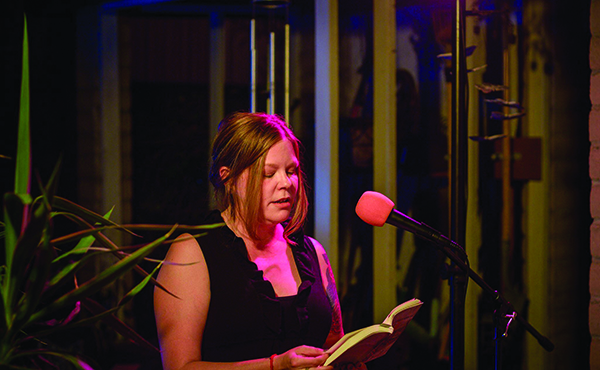
Selah Saterstrom reading at a recent Fair Weather Reading Series event.
Photo courtesy Kristen Nelson
“This is a place that has always catered to people’s passions,” explains Kristen Nelson, cofounder and current, but soon-to-be previous, executive director of literary arts nonprofit Casa Libre en la Solana.
“It’s a place where people with a passion, idea or concept could say, ‘Hey, I want to do this,’ and Casa Libre would say, ‘Yes, how can we help you?’”
Nelson makes it clear that the writing center she’s helmed for over 13 years is not closing its doors; it is going forward full steam ahead and actively searching for a new leader to carry the organization’s mission, spirit and “have the agency to create what they want with this place and incorporate what they are passionate about, what they care about.”
It’s a chilly Friday night in December, but Nelson and I stay warm under a propane heater. We’re sitting, bundled up, in the breezeway of her 1898 commercial adobe property on Fourth Avenue that shares the same name as the literary organization. Wine and snacks are being enjoyed in relaxed camaraderie because – full disclosure – Nelson and I have been professional colleagues and friends for many years. She reflects on Casa Libre’s history (inextricable from her own), what informed its creation, evolution and what the nonprofit is looking for in its new executive director when Nelson steps down on June 30, 2017.
Incorporated in July 2003, Casa Libre has operated as a connection point for the Tucson writing community for close to 14 years, offering an event space for readings, salons, book releases, workshops, fundraisers – and certainly some hell raisers – to serve groups traditionally not supported by mainstream writing outlets.
“We have tailored our vision and our mission specifically to writers of color, female writers, LGBTQIA writers, and emerging

An example of a kite made as part of “Made for Flight,” a youth project started by T.C. Tolbert at Casa Libre to commemorate the lives of murdered transgender people with kite building and poetry writing.
Photo courtesy Kristen Nelson
writers and other underserved groups,” the 38-year-old elucidates. “In the last two years, the board of directors and I recognized how important it was to have that as a stated mission and say, ‘This is why we’re here, this is your place.’ And everyone is welcome to come and be a part of that and enjoy those voices, but we want to serve these voices.”
As a queer female, Nelson is one of those voices. She shares her experiences as a youth in a multiracial neighborhood in Mount Vernon, New York and how that taught her to embrace and celebrate different perspectives. Her racially diverse community, where Nelson was in the white minority, was comprised of socially conscious families engaged in activism and connected to the larger world.
“When I was growing up, my mom got involved in this program called CISV, Children’s International Summer Villages, and we had international students live in our home for months at a time. I learned about different cultures all over the world – Costa Rica, Guatemala, Portugal, France, Spain, Taiwan, Egypt, Greece. I grew up with this sense that the United States is not centric; we are part of a world community.
“And then I just started paying attention. I recognized that I was queer somewhere around 16-years-old. I grew up in a family that was incredibly loving and supportive of who I am, they always have been – regardless of sexual identity, regardless of career path – and really believed in the concept that you can do anything you want to do.”
As Nelson navigated college and met other queer individuals and people of different races, she recognized the privilege she had even as she was personally experiencing discrimination.
“I saw my own challenges in terms of publishing, in terms of sharing my work, getting my voice heard. From my own personal experience and paying attention to other voices that were trans voices, paying attention to people of color’s voices, international voices and how much harder so many underserved groups in the world have it. I recognized that I would never be imprisoned for writing a poem and what a privilege that was. Growing up in an activist, socially conscious, super, super liberal family helped. And that taught me to pay attention, and from there, that grew.”
While at the University of Tampa – as a junior with only three semesters left on her scholarship – Nelson knew she had to change her major from marine biology to English. “I feel like college taught me to pursue my passions, it was really then that I started to identify as a writer,” Nelson shares. She jumped right into the field with a summer internship at The Village Voice in 1999, worked as a journalist post-graduation at The Rivertowns Enterprise and then 9/11 happened.
Nelson describes New York City as being in chaos and how her sources were calling to describe the violence happening against Muslims and people who were presumed to be Muslim, articles she knew were important to write. But her publisher refused to print those stories, saying the charged topics were too political.
“I thought, ‘This isn’t why I am a journalist. I’m a journalist to tell the truth, I’m a journalist to report.’ I took that really seriously. When I left New York, I was jaded after that experience and decided I wanted to work in a different field. I wound up, because of my science background, getting a job (eight months after arriving in Tucson) at what is now UA’s Institute of the Environment.”
It was the idea of starting Casa Libre with her then-partner that brought the two of them to Tucson in April 2003. The couple had envisioned an organization that would serve as both a community center and a space to host writers’ residencies – which is exactly what they did.
She explains that they were “looking for a fresh start in a place that had a vibrant queer community, a vibrant arts community, and a sense of opportunity about it. The literary community here was already so rad. Kore Press had been around for 10 years already; the Poetry Center was thriving and raising money to build their new building at the time. Spork Press, Chax Press, POG, Tucson Poetry Festival, all of these organizations really embraced Casa Libre. When I started to meet the folks running those organizations, they were excited to collaborate and support something new. In particular at the time, the Poetry Center and Kore Press – Lisa Bowden was such a huge supporter of Casa Libre from the beginning – so it felt like there were these big sisters and brothers and siblings that were out there going, ‘Come on, you can do this here.’ I felt really engaged from the beginning. It turned from a concept, a dream and a website within a year to an organization.”
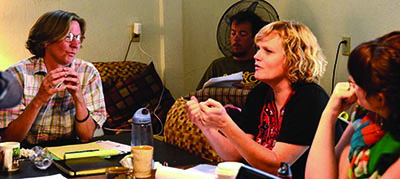
Weekend writing residency led by Rebecca Brown, left; also pictured are Frankie Rollins (center), T.C. Tolbert (background) and Lisa O’Neill (far right).
Photo courtesy Kristen Nelson
Casa Libre’s writer residency program worked for several years, during a period when Nelson was able to secure scholarships through private donations for the winning grantees. When the Great Recession hit in late 2008, the private funding streams dried up and Nelson turned the short-term writers’ residencies into long-term artist live/work spaces over a period of two years.
Throughout Casa Libre’s existence, it has continually strived to adapt to the changing needs of Tucson’s community by hosting meetings to discuss the organization’s role in serving the writing populace. “If you want to know how to better serve your community,” says Nelson. “Ask your community. There’s no mystery there.”
Lisa Bowden, Kore Press’ publisher/cofounder and a longtime collaborator with Nelson, describes Casa Libre as being “a vital center in the community for the literary arts, for discussion and exchange of ideas. An incredible, glowing, magnificent force.” Bowden also shares that partnerships between Kore Press and Casa Libre have included various community projects, activism workshops for youth, along with holding other writing workshops in Casa’s library.
There’s been a bevy of programs Casa Libre has hosted over the years. Nelson easily rattles off a short list – The Writers Studio, The Edge: Emerging Writers, Stjukshon: An Indigenous Reading Series, Kore Press’ First Book winners.
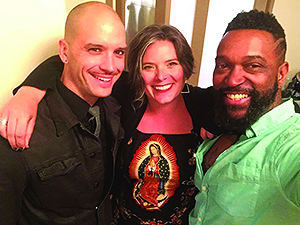
Left to right: Logan Phillips, Kristen Nelson and Roger Bonair-Agard after Logan and Roger’s reading at Casa Libre’s Fair Weather Reading Series.
Photo courtesy Kristen Nelson
“This is also where, after Maggie Golston’s downtown book shop Biblio closed down, Maggie contacted us and said, ‘Hey, I need a place for WIP (Writers In Progress, a UA MFA curated reading series) to be,’ and we housed WIP for eight to nine years.
“There was a need for Casa Libre because we were able to be a central kind of organizing unit for a bunch of different projects. I always pictured us as an octopus, where we had this central head but there were all these tentacles and each of those tentacles were organized by a person or community group. Those are the niches we filled.”
There comes a time for any writer who has worked hard on community projects for years to get to the point where they need to get back to focusing on writing. That time has come for Kristen Nelson. During her almost 14-year tenure at the helm of Casa Libre, she has been a renovator, maintenance person and landlord for her property. She went and got an MFA in creative writing from Goddard College, worked as an adjunct professor at Pima Community College for four years and currently is the program coordinator at UA’s Institute for LGBT Studies.
“That’s my trajectory of professional history, but that whole time, running Casa Libre. And for nine of the 14 years that I’ve run this place, it was unpaid, and that’s not something I want to pass on to the new executive director. Which is why I am not taking a salary this year, we’re fundraising, and we’re getting money in the bank so no one will be in that position again.”
As we circle back to chat about Casa Libre’s upcoming events – the Fair Weather Reading Series, happening mostly monthly January through May – Nelson lights up and says, “T.C. Tolbert, we haven’t talked at all about T.C.!” She shares that Tolbert was the organization’s assistant director for seven years, who started and ran the Trickhouse events with Noah Saterstrom.
“I started the Fair Weather Reading Series about two years ago, so that was the time T.C. decided to step down as the assistant director to pursue other professional opportunities, with so much love. That was when I started envisioning leaving Casa Libre myself because my best friend and collaborator claimed that opportunity for himself and I thought, ‘Oh wait, wait, and now you’re writing more?’ But I knew that I couldn’t hand over this octopus unpaid to somebody.”
Nelson and her board are in full fundraising mode, she says they are about 40% to their goal and is confident they will reach it by July 1, 2017.
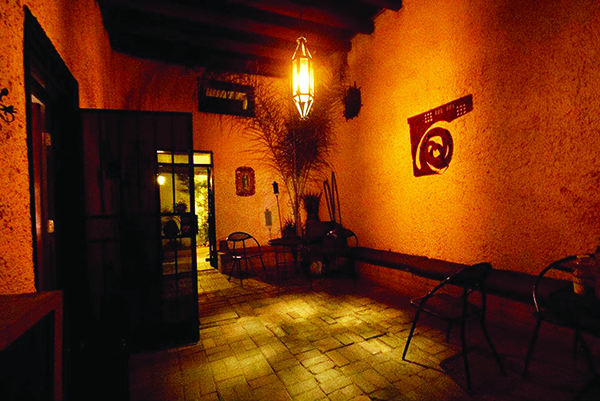
Casa Libre’s outside courtyard.
Photo courtesy Kristen Nelson
Board president Sara Wolfe Vaughan says she is “excited to see what the future holds both for Casa Libre and for Kristen. I’m truly elated that Kristen will have more time to devote to her own art. It’s something she so deserves and we need her work out in the world, maybe now more than ever. Tucson has no shortage of talented artists and I can’t wait to meet our candidates.”
Reflecting on what they are looking for in a new leader, Nelson shares that they’d “really like somebody who has some experience running events, particularly in the nonprofit world and also someone who has development experience. Someone who has the skills to continue it forward in a new way.”
To donate, visit CasaLibre.org/donate.html. The Fair Weather Reading Series is Jan. 17, 7 p.m. A $5 donation gains entrance at 228 N. 4th Ave. to hear from Garnette Cadogan, Jordan Flaherty and Yanara Friedland. Learn more at CasaLibre.org/events.html. Check out Nelson’s writings and sundries at KristenENelson.com.

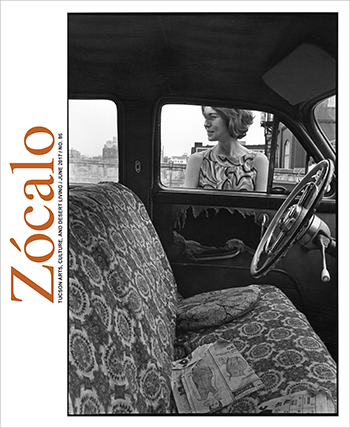
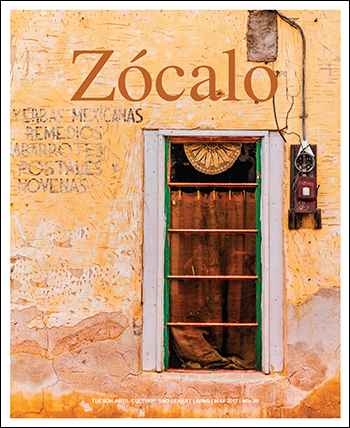
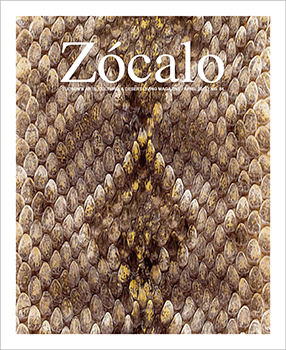
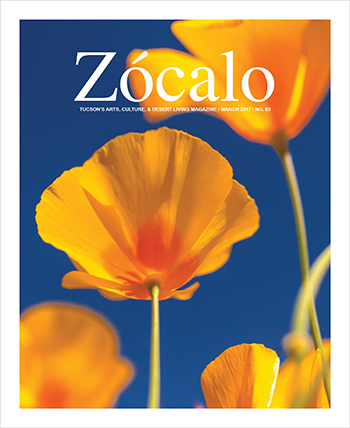
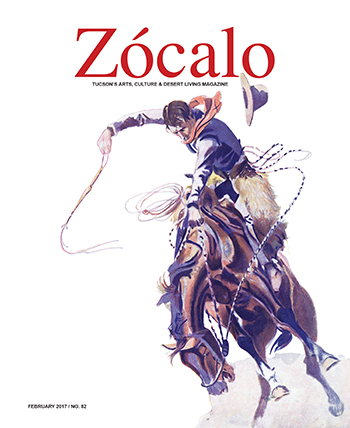
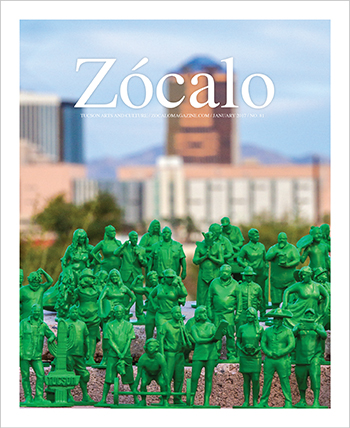




Also find us on...